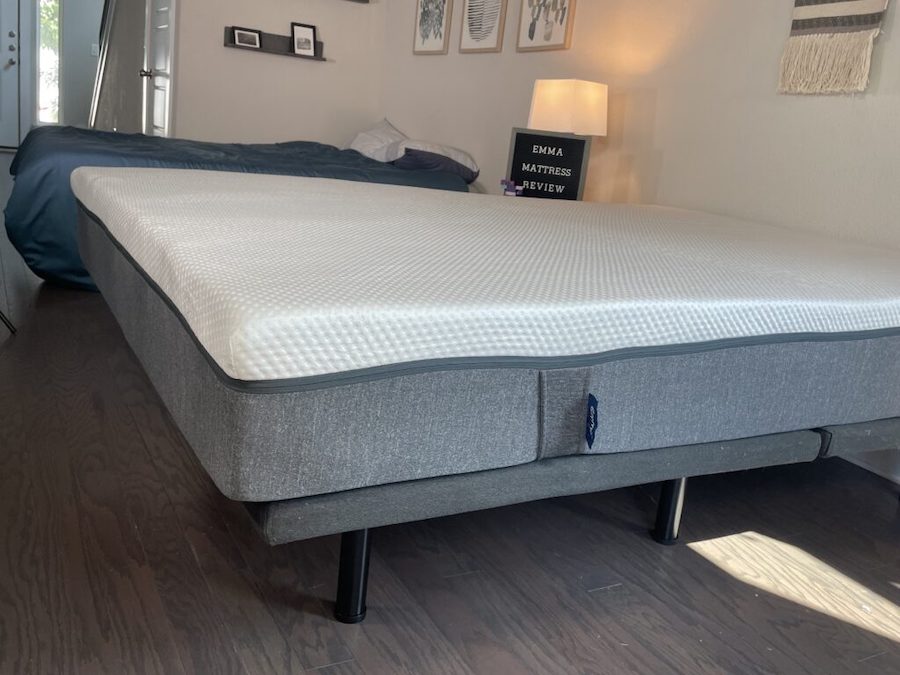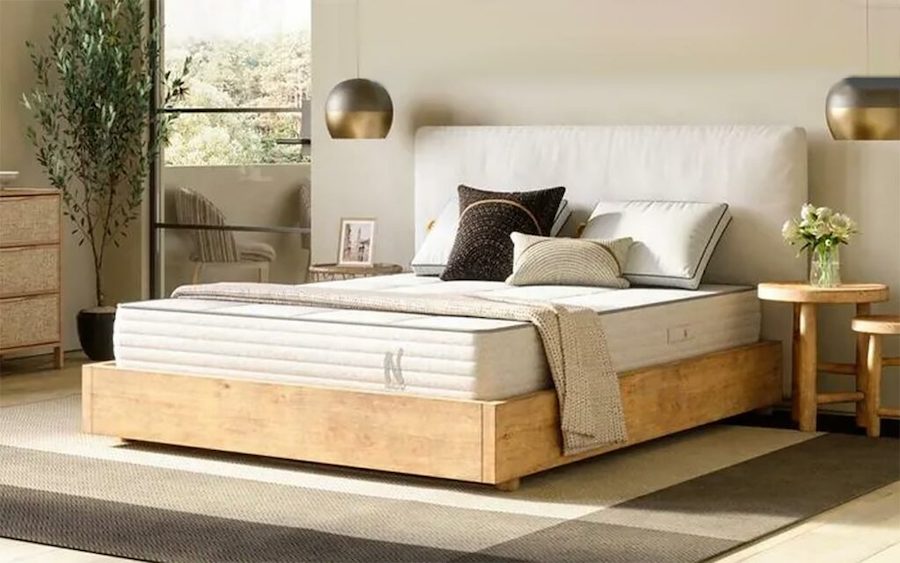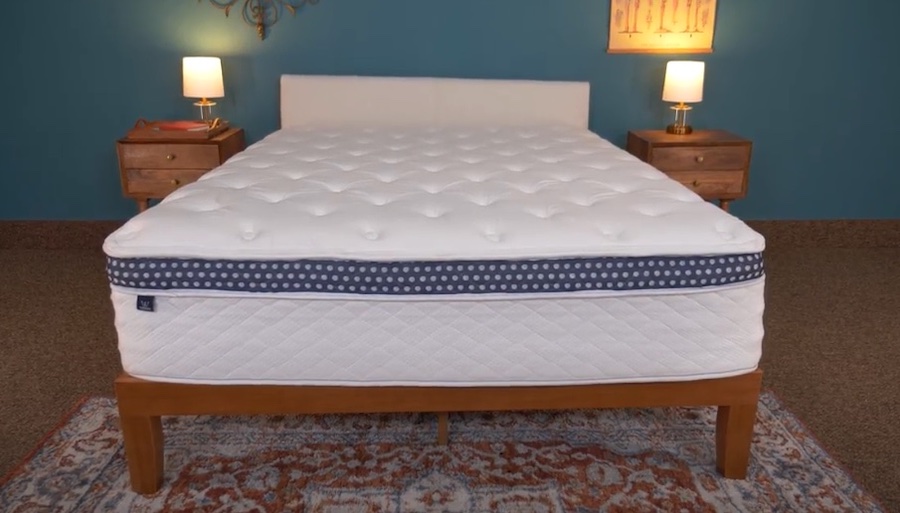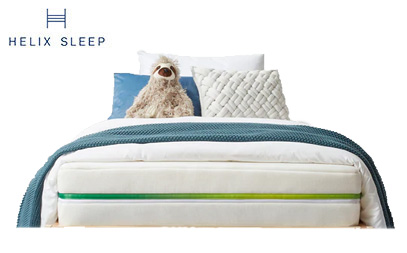Looking to purchase a smaller mattress but not sure whether to choose a Twin or a Full? There is a lot of confusing lingo out there in the mattress world, but our Twin vs. Full comparison guide is here to help you out. So what actually is the difference?
Twins, sometimes called singles, are the smallest standard beds out there. Fulls, or Doubles, are a bit wider overall but smaller than a Queen. We will break down the exact dimensions, pros and cons, and considerations below so that you can decide which is the winner for you.
Twin vs. Full Mattress Comparison Chart
| Twin | Twin XL | Full | Full XL | |
| Width | 38” | 38” | 54” | 54” |
| Length | 75” | 80” | 75” | 80” |
| Price | Least expensive | Slightly more expensive than Twin | More expensive than Twin XL | Slightly more expensive than Full |
| Best For | Children and teens, solo sleepers, guest rooms, extra-small bedrooms | Taller children and teens, solo sleepers, guest rooms, extra-small bedrooms | Solo sleepers who want to spread out, guest rooms, bedrooms with a bit more space | Taller solo sleepers who want to spread out, guest rooms, bedrooms with a bit more space |
Best Twin Mattresses
- Helix Midnight Luxe – Best Cooling Twin Mattress
- Emma Original – Best Twin Mattress for Pressure Relief
- Nolah Natural – Best Hypoallergenic Twin Mattress
- WinkBed – Best Firm Twin Mattress
- Bear – Best Twin Mattress for Back Pain
Check out our full list of the best Twin mattresses
Best Full-Size Mattresses
- Saatva Classic – Editor’s Pick
- Helix Kids – Best Full-Size Mattress for Kids
- WinkBed – Best Full-Size Hybrid Mattress
- Nectar – Best Cheap Full-Size Mattress
- DreamCloud – Best Full-Size Mattress for Couples
Check out our full list of the best Full-size mattresses

|

|

|

|

|

|

|

|

|

|
|
| Helix Midnight Luxe Mattress | Emma Mattress | Nolah Natural Mattress | WinkBed Mattress | Bear Mattress | Saatva Mattress | Helix Kids Mattress | WinkBed Mattress | Nectar Mattress | DreamCloud Original Mattress | |
| Rating | ||||||||||
| Firmness | Soft: 6/10 | Soft: 5/10 | Soft: 6/10 | Multiple firmness options | Medium-firm: 6.5/10 | Multiple firmness options | Multiple firmness options | Medium-firm: 6.5/10 | Medium-firm: 6.5/10 | |
| Material | Hybrid | Foam | Latex | Hybrid | Foam | Innerspring | Hybrid | Hybrid | Foam | Hybrid |
| Cooling | — |
|
|
|
|
|
|
|
— |
|
| Warranty | 15-year warranty | 10-year warranty | Lifetime warranty | Lifetime warranty | Lifetime warranty | Lifetime warranty | 10-year warranty | Lifetime warranty | Lifetime warranty | Lifetime warranty |
| Shipping | Free shipping | Free shipping | Free shipping | Free shipping | Free shipping | Free white glove delivery | Free shipping | Free shipping | Free shipping | Free shipping |
| Trial Period | 100 nights | 365 nights | 120 Nights | 120 nights | 120 nights | 365 nights | 100 Nights | 120 nights | 365 nights | 365 nights |
| Best For | Back Sleepers, Stomach Sleepers, Side Sleepers | Hot Sleepers, Kids, Back Sleepers | Side Sleepers, Back Sleepers, Stomach Sleepers, Hot Sleepers, Back Pain | Back Sleepers, Stomach Sleepers, Back Pain, Hot Sleepers, Side Sleepers | Hot Sleepers, Back Sleepers, Side Sleepers | Back Sleepers, Stomach Sleepers, Back Pain, Hot Sleepers | Side Sleepers, Back Sleepers, Stomach Sleepers, Kids, Hot Sleepers | Back Sleepers, Stomach Sleepers, Back Pain, Hot Sleepers, Side Sleepers | Back Sleepers, Side Sleepers, Hip Pain, Joint Pain | Back Sleepers, Hot Sleepers, Seniors |
What to Consider When Choosing a Twin or Full Mattress
Dimensions
Twin
Twin mattresses are around 38 inches wide and 75 inches long. This is the smallest standard mattress size, and Twin beds are commonly used in children’s rooms and guest rooms, and among single sleepers.
See more: Best Twin Mattress
Twin XL
The Twin XL size is a bit longer than a regular Twin, measuring 38 inches wide and 80 inches long. These are great for adults or taller kids.
Learn more: Best Twin XL Mattress
Full
Full-size beds are 54 inches wide and 75 inches long, though there may be some brands will Full mattresses that are 53 inches wide. A Full is smaller than a Queen — the most commonly purchased bed — but is 16 inches wider than a Twin, giving sleepers some extra wiggle room. Couples sometimes sleep on this size, but they are more commonly being used by singles.
Learn More: Best Full Mattress
Full XL
A Full XL mattress is 5 inches longer than a standard Full, at 54 inches wide and 80 inches long. However, some Full XLs, depending on the brand, may be 53 inches wide.
Price
Twins are usually cheaper than Full beds because of their smaller size. Also, accessories like sheet sets, bed frames, and pillows (you will probably want two on a bigger bed) will be more expensive.
Comfort
Another key factor is the person sleeping in the bed and how comfortable they’ll be. A child or average-size adult should fit just fine on a Twin, but bigger children and most adults would probably be more comfortable on a Full. Those who are taller, especially, would benefit from the extra 5 inches that the XL options offer.
Bedding
Sheets, comforters, and other bedding accessories can add style and comfort to your bed, and since Twin and Full are popular mattress choices, you shouldn’t have a problem finding items you like. Full XL is the least common of these sizes, though, so you’ll likely have a harder time finding sheets, in particular, that line up with this size.
Room Size
The size of the room matters almost just as much as the mattress size; you do not want a bed that is going to overpower the space, but you also don’t want one that will look too small.
Fulls generally work best in a room 10 feet by 12 feet or 10 feet by 10 feet. Twins can accommodate smaller rooms or even allow for more furniture in rooms that are 10 feet by 10 feet and bigger. However, we recommend avoiding using a Twin in a much larger master bedroom since this could look out of place.
Related: Best Murphy Bed Mattress
Twin and Full-Size Mattress Pros and Cons
Twin-Size Mattress Pros
- More affordable
- Take up less space
- Less expensive accessories
- Smaller and easier to move
Twin-Size Mattress Cons
- Not as much room to spread out for larger adults
- May have a lower weight capacity
- Children may grow out of it quickly
Full-Size Mattress Pros
- More space for a single person
- Works well for both adults and children
- Accessory sizes are easy to find
Full-Size Mattress Cons
- More expensive than a Twin
- Larger and more cumbersome to move
- Too small for most couples
When It’s Good to Use a Twin Bed or a Full Bed
Twin
Twin beds are useful for children making the transition out of the crib into a “big kid bed.” Bunk beds, which are popular for kids, typically accommodate Twin mattresses. They are also the ultimate space saver for those who live in apartments or have kids sharing a room.
Twin-size beds are a breeze to move because of their size and weight compared to other mattresses, which means that flipping or rotating your mattress to prolong its lifespan is not as much of a chore.
You may commonly see Twin XLs in college dorms and hostels because they do not take up too much space but are long enough for adults to sleep comfortably on. They can also be great for couples who want an adjustable bed frame because two Twin XLs pushed together are the size of a standard King.
Full
Full-size beds are helpful for single adults who are larger or simply want more space to spread out. Although couples could potentially sleep on this size, it would be a squeeze. If your master bedroom is smaller, this could be a good option.
While Twin beds are great for guest rooms, Full-size beds are more versatile for all different types of guests. Also, parents looking to get more longevity from their kid’s mattress may choose to skip the Twin option and move straight into this size because of how versatile it is, allowing their kids to move into their teens with the same sleeping space.
This size will look great in the majority of rooms and should still leave plenty of space for other furniture.
Related: Best Mattress for Airbnbs
FAQs About Twin vs. Full Mattresses
Is a Twin or Full mattress better?
Twin and Full mattresses each have their own advantages, so one mattress size isn’t necessarily better than the other; it’s more about what works for the needs of you and your family. Twin mattresses, for example, give shoppers extra savings because their smaller size means they’re less costly. On the flip side, Full mattresses offer consumers more versatility with their larger surface space.
When should I switch from a Twin to a Full bed?
The timing for switching from a Twin to a Full bed is largely dependent on your circumstances. When children move on from their crib, it is often into a Twin bed. However, as kids grow, they may want more room to move around and stretch out when they sleep. At this time, you may want to consider a Full-size bed.
This isn’t a mandatory or necessary change. If a Full bed doesn’t work for your budget or your room, a Twin bed is suitable for most children, teenagers, and even adults. However, if you’re going with a Twin and the sleeper is over 6 feet tall, you’ll likely want to opt for a Twin XL as it will better accommodate their height.
Are Twin beds okay for adults?
Yes! Twin beds are a perfectly suitable mattress choice for most adults who are sleeping alone. With a width of around 38 inches, most average size adults should be able to find comfort on a Twin bed. However, adults who are taller or heavier may prefer a larger mattress size that can better accommodate their body type.
Are twin beds good for toddlers and kids?
Either would work great for toddlers and kids. A Full would leave quite a bit of room for a toddler, but if you are looking for something to keep for years, it would be a great option to grow into.
Learn More: Mattress for Kids
What are the dimensions of twin beds in centimeters?
A standard Twin is 96.52 centimeters wide and 190.5 centimeters long. Twin XLs are the same width and 203.2 centimeters long.
Standard Fulls are 137.16 centimeters wide and 190.5 centimeters long. Full XLs are also 137.16 centimeters wide and 203.2 centimeters long.
Conclusion
Both Twin and Full beds are ideal for certain situations, but the differences between the two are pretty clear. In general, these sizes work best for single sleepers, children, guest rooms, or small spaces. Making your decision based on room size, the person sleeping in the bed, and expense is probably your best bet for a comfortable night’s rest.

Jill Zwarensteyn
Editor
About Author
Jill Zwarensteyn is the Editor for Sleep Advisor and a Certified Sleep Science Coach. She is enthusiastic about providing helpful and engaging information on all things sleep and wellness.
Combination Sleeper